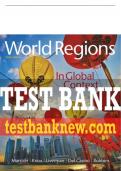Test Bank For World Regions in Global Context: Peoples, Places, and Environments 6th Chapter 1 World Regions in Global Context Chapter 1 World Regions in Global Context 1) The average number of children each woman will have over the course of her lifetime is called the: A) Maternal Mortality Rate B) Birth Rate C) Fertility Rate D) Infant Mortality Rate E) None of the above Answer: C Diff: 3 Section: Culture and Populations Geog. Standard: N9 The characteristics, distribution, and migration of human populations on Earth's surface Bloom's Taxonomy: Applying/Analyzing Global Sci Out: G2 Demonstrate the ability to think critica lly and employ critical thinking skills. Learning Obj: 1.33 Describe the global distribution of human population, including megacities. 2) The U.N. Human Development Index (HDI) is based on: A) life expectancy, education, fertility rate B) life expectancy, education, income C) education, income, death rate D) education, income, fertility rate E) education, gender, death rate Answer: B Diff: 3 Section: History, Economy, and Territory Geog. Standard: N9 The characteristics, distribution, and migration of human populations on Earth's surface Bloom's Taxonomy: Remembering/Understanding Global Sci Out: G2 Demonstrate the ability to think critically and employ critical thinking skills. Learning Obj: 1.21 Describe the main indicators of social and economic advancement, including GDP, GNP, PPP, and HDI. 1 Test Bank For World Regions in Global Context: Peoples, Places, and Environments 6th Chapter 1 World Regions in Global Context 3) In 2013, the world's annual average GNI per capita Purchasing Power Parity (PPP) was: A) $950 B) $5,950 C) $10,700 D) $54,040 E) $102,610 Answer: C Diff: 4 Section: History, Economy, and Territory Geog. Standard: N11 The patterns and networks of economic interdependence on Earth's surface Bloom's Taxonomy: Remembering/Understanding Global Sci Out: G3 Read and interpret graphs and data. Learning Obj: 1.21 Describe the main indicators of social and eco nomic advancement, including GDP, GNP, PPP, and HDI. 4) What is an "emerging world region"? A) system of political -economic, sociocultural and environmental elements B) connected locations with shared and distinct characteristics C) areas with similar cli mate and physical conditions D) political and economic system dominant by another society E) none of the above Answer: B Diff: 2 Section: Thinking Like a Geographer Geog. Standard: N5 That people create regions to interpret Earth's complexity Bloom's Taxonomy: Remembering/Understanding Global Sci Out: G2 Demonstrate the ability to think critically and employ critical thinking skills. Learning Obj: 1.2 Discuss the role of place, landscape, and the geographical imagination in creating feelings of region alism. 5) The global movement of air that transports heat and moisture and explains the climates of different regions is called: A) atmospheric circulation B) wind belts C) air pressure D) air masses E) none of the above Answer: A Diff: 1 Section: Environment, Society, and Sustainability Geog. Standard: N4 The physical and human characteristics of places Bloom's Taxonomy: Remembering/Understanding Global Sci Out: G7 Demonstrate the ability to make connections between concepts across Geography. Learning Obj: 1.8 Summarize how Earth systems interact to produce climate systems and regional climates. 2 Test Bank For World Regions in Global Context: Peoples, Places, and Environments 6th Chapter 1 World Regions in Global Context 6) The Tropic of Capricorn is: A) 23.5 degrees South latitude B) 23.5 degrees North latitude C) 0 degrees West longitude D) 180 degrees East latitude E) 75 degrees West latitude Answer: A Diff: 1 Section: Environment, Society, and Sustainability Geog. Standard: N4 The physical and human characteristics of places Bloom's Taxonomy: Remembering/Understanding Global Sci Out: G7 Demonstrate the ability to mak e connections between concepts across Geography. Learning Obj: 1.1 Explain how world regional geography relates to physical, human, and environmental geography. 7) What is the Tabula Rogeriana? A) the "map of the known world" in 1154 B) made by Islamic ca rtographer Muhammed al -Idrisi C) orients the south on the top of the map D) all of the above E) none of the above Answer: D Diff: 4 Section: Environment, Society, and Sustainability Geog. Standard: N1 How to use maps and other geographic representations , geospatial technologies, and spatial thinking to understand and communicate information Bloom's Taxonomy: Applying/Analyzing Global Sci Out: G3 Read and interpret graphs and data. Learning Obj: 1.3 Explain how maps and mapping are used in the study of world regional geography. 8) Trade Winds blow from which direction? A) East B) South C) North D) West E) both East and West Answer: A Diff: 3 Section: Environment, Society, and Sustainability Geog. Standard: N4 The physical and human characteristics o f places Bloom's Taxonomy: Applying/Analyzing Global Sci Out: G7 Demonstrate the ability to make connections between concepts across Geography. Learning Obj: 1.8 Summarize how Earth systems interact to produce climate systems and regional climates. 3




